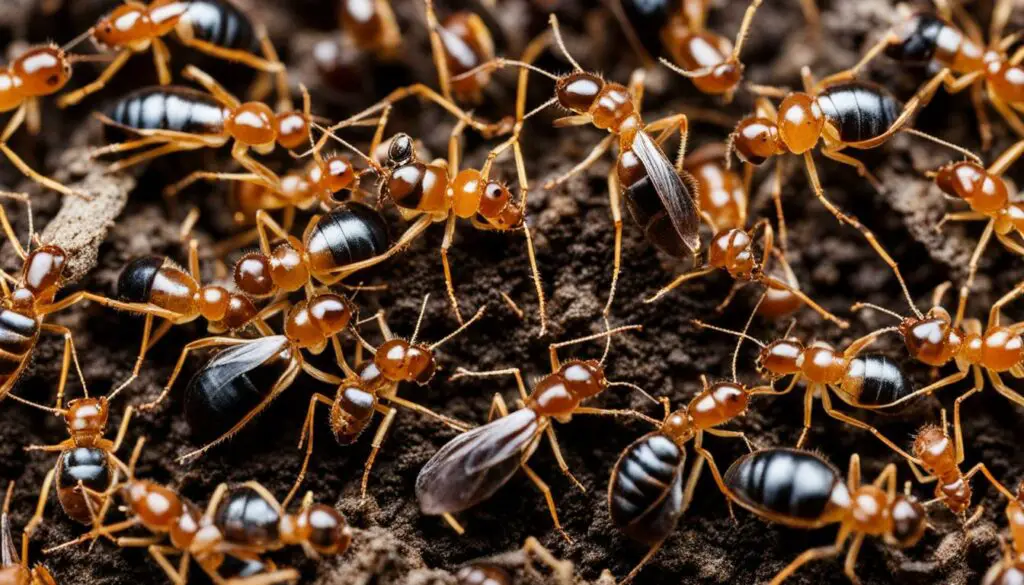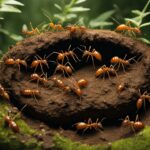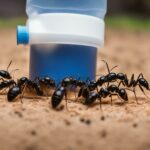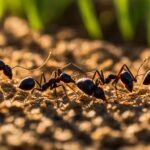Ant colonies go through a remarkable journey of growth and development. Understanding the timeline of their growth can provide valuable insights into their complex social behavior.
Ant colonies function as highly organized societies known as superorganisms. These superorganisms are united in their common goals of survival, growth, and reproduction. The stages of ant colony development involve the queen, adult workers, and brood consisting of eggs, larvae, and pupae. Ants build their nests in a variety of places, including underground, in leaf litter, or even in trees. Their nests are designed to provide a suitable environment for the growth of their larvae. The size of ant colonies can vary greatly, with some colonies numbering in the millions.
Within an ant colony, different individuals have specific roles and responsibilities. The queen’s main role is to lay eggs, while worker ants perform various tasks depending on their age. Younger ants care for the queen and brood, while older workers gather food and defend the nest. Ants primarily communicate using chemicals called pheromones, which they release and detect with their antennae. These pheromones carry specific messages related to food sources or intruder threats. Ants also recognize each other through the chemical signatures on their bodies.
Ant colonies have the ability to solve complex problems collectively. They can compare potential nest sites and collectively make decisions for the betterment of the colony. This collective decision-making process allows ants to make more informed choices and avoid potential mistakes. Ants employ various survival strategies, including hunting in groups to overcome larger prey and defending their colonies against invaders. Some ants, such as leafcutter ants, engage in farming by cultivating fungus gardens for nutrition.
While ants are loyal to their own colony, they can exhibit aggression towards neighboring colonies. Competition for resources often leads to intercolony aggression and territorial battles. Workers use stinging, spraying, and biting as defense mechanisms during these conflicts. Ant colony optimization (ACO) is an algorithmic technique inspired by the foraging behavior of ants. It is widely recognized as one of the most successful computational methods for solving complex combinatorial optimization problems. ACO algorithms mimic the decision-making processes of ants to find optimal solutions.
The idea of using ant behavior as a basis for optimization algorithms emerged in the early 1990s. Scientists observed how ants find shortest paths using pheromone communication. This observation led to the development of the ACO metaheuristic, which applies the principles of ant behavior to solve optimization problems. The traveling salesman problem (TSP) serves as a fundamental benchmark for testing ACO algorithms. Various ACO algorithms, such as Ant System and its successors, have been developed specifically for solving the TSP.
Key Takeaways:
- Ant colonies go through a remarkable journey of growth and development.
- Ant colonies are highly organized societies known as superorganisms.
- The stages of ant colony development involve the queen, adult workers, and brood.
- Ants build nests in various locations to provide a suitable environment for larvae growth.
- Ants communicate using chemicals called pheromones and recognize each other through chemical signatures.
The Secret Behind Ants’ Success: The Superorganism
Ant colonies function as highly organized societies known as superorganisms. These superorganisms are united in their common goals of survival, growth, and reproduction. Understanding the stages of ant colony development can provide valuable insights into the fascinating world of ants.
The stages of ant colony development involve the queen, adult workers, and brood consisting of eggs, larvae, and pupae. The queen plays a crucial role in laying eggs, ensuring the continuation of the colony. Adult workers, on the other hand, perform various tasks depending on their age. Younger workers take care of the queen and brood, while older workers gather food and defend the nest.
The coordination and cooperation among colony members are what make ants such successful organisms. Each individual has a specific role to play, contributing to the overall functioning and growth of the colony. This collective effort, known as the superorganism, allows ants to thrive in diverse environments and adapt to changing conditions.
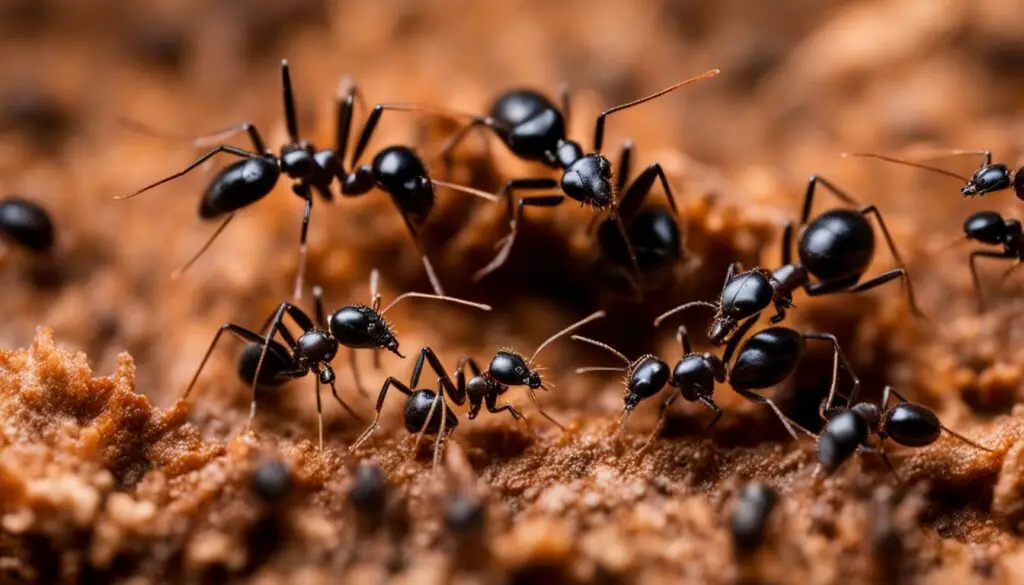
The Importance of Communication
Communication plays a vital role in the success of ant colonies. Ants primarily communicate using chemicals called pheromones, which they release and detect with their antennae. These pheromones carry specific messages related to food sources or intruder threats. Through chemical communication, ants can coordinate their activities and respond effectively to environmental cues.
| Ant Colony Development Stages | Description |
|---|---|
| Queen | The reproductive female in the colony responsible for laying eggs. |
| Workers | Adult female ants that perform various tasks such as foraging, nest maintenance, and caring for the queen and brood. |
| Brood | Consists of eggs, larvae, and pupae. The brood represents the future generation of the colony. |
“Ant colonies are truly remarkable examples of collective intelligence, where every individual contributes to the success of the whole. The superorganism concept exemplifies the power of cooperation and coordination in nature.”
Creating the Perfect Home: Nest Building
Ants are master builders, creating intricate nests that serve as their homes and provide a suitable environment for the growth and development of their colony. These nests can be found in a variety of locations, including underground, in leaf litter, or even in trees. Each nest is carefully designed to meet the needs of the ant colony and ensures the survival of its members.
Ant nests come in all shapes and sizes, depending on the species and the availability of resources in their environment. Some ant colonies have nests consisting of a single chamber, while others have an extensive network of interconnected chambers and tunnels. The size of ant colonies can vary greatly, with some colonies numbering in the millions. These large colonies often have complex nest structures with multiple entrances and chambers to support the needs of their growing population.
The construction of ant nests is a collective effort, with different members of the colony contributing to the building process. Worker ants excavate tunnels, carry materials, and create chambers within the nest. They use a combination of their jaws and legs to dig through soil, move debris, and shape the nest according to their needs. The result is a network of tunnels and chambers that provide protection from predators, regulate temperature and humidity, and facilitate the care and growth of the brood.
The Role of Nest Architecture
The design of ant nests plays a crucial role in the success and survival of the colony. The architecture of the nest helps optimize resource allocation, minimize exposure to potential threats, and maintain optimal conditions for the development of the brood. The location of the nest and its structural features, such as ventilation, insulation, and moisture control, are carefully considered to ensure the colony’s well-being.
Nest building is a dynamic process that continues throughout the life of the ant colony. As the colony grows and expands, new chambers and tunnels are constructed to accommodate the increasing population. In some cases, ant colonies may even use existing structures or take over abandoned nests of other species, modifying them to suit their needs.
Nest building is a fascinating aspect of ant behavior that showcases their remarkable ability to adapt and thrive in diverse environments. By understanding the intricacies of ant nest construction, we gain insights into the complex social structures and survival strategies of these tiny yet highly organized creatures.
| Key Points |
|---|
| Ants build nests in various locations, including underground, in leaf litter, or in trees. |
| Nest size can vary greatly, with some colonies numbering in the millions. |
| Worker ants excavate tunnels, carry materials, and shape the nest. |
| Nest architecture plays a crucial role in resource allocation and colony survival. |
| Nest building is a dynamic process that continues as the colony grows. |
The Power of Cooperation: Division of Labor
One of the key factors that contribute to the growth and success of ant colonies is their remarkable ability to divide labor efficiently. Within an ant colony, each individual has specific roles and responsibilities that contribute to the overall functioning and survival of the colony. This division of labor ensures that all necessary tasks are performed, allowing the colony to thrive.
The queen plays a crucial role in the division of labor within the ant colony. Her primary responsibility is to lay eggs, ensuring the continuation of the colony’s population. The queen’s reproductive role is of utmost importance, as she is the source of new generations of ants.
In addition to the queen, worker ants play a vital role in the division of labor. The tasks performed by worker ants vary depending on their age and specialization. Younger worker ants typically care for the queen and brood, attending to their needs and ensuring their well-being. As worker ants age, they take on more specialized tasks such as foraging for food and defending the nest from potential threats.
| Age of Worker Ant | Task |
|---|---|
| Young | Caring for the queen and brood |
| Intermediate | Foraging for food |
| Older | Defending the nest |
Ant colonies exemplify the power of cooperation and specialization. Each ant has a specific role to play in the colony, ensuring that all necessary tasks are completed. This division of labor allows ant colonies to efficiently allocate resources, protect their nests, and ultimately thrive in their environments.
The division of labor within ant colonies is a remarkable example of cooperation and adaptation in the natural world. By assigning specific roles and responsibilities to different individuals, ant colonies are able to function as highly organized societies. This division of labor contributes to the overall growth and success of ant colonies, allowing them to thrive in a wide range of environments.

The Benefits of Division of Labor
The division of labor within ant colonies provides several benefits that contribute to their growth and survival. First and foremost, it ensures that all necessary tasks are completed. By assigning specific roles to different individuals, ant colonies can efficiently allocate resources and energy towards essential activities such as caring for the queen, gathering food, and defending the nest.
- Efficient allocation of resources: With different ants specializing in specific tasks, resources can be allocated efficiently, maximizing the colony’s chances of success.
- Increased productivity: The division of labor allows ants to focus on their specific roles, resulting in increased productivity and overall efficiency.
- Reduced competition: By assigning different tasks to different ants, competition within the colony is minimized, leading to a more harmonious and cooperative environment.
The division of labor within ant colonies is a highly effective strategy that allows these tiny creatures to accomplish remarkable feats. Through specialization and cooperation, ant colonies are able to adapt to their environments, grow in size, and ensure the survival of their species for generations to come.
Communicating without Words: Chemical Communication
Ants have developed a highly sophisticated system of communication without the use of words. They rely on chemical signals called pheromones to convey messages to other members of their colony. Pheromones are released by ants and detected by their antennae, allowing them to communicate important information about food sources, potential threats, and even their own identity.
One type of pheromone is used to mark trails leading to food sources. Worker ants follow these trails to efficiently gather food for the colony. They can also lay down a different type of pheromone to signal alarm, alerting other ants to the presence of danger. By using these chemical signals, ants can coordinate their activities and respond quickly to changes in their environment.
In addition to trail marking and alarm signals, ants also use pheromones to recognize each other. Each ant colony has a unique scent profile, which allows ants to distinguish between members of their own colony and intruders. This chemical signature plays a crucial role in maintaining the integrity and security of the colony.
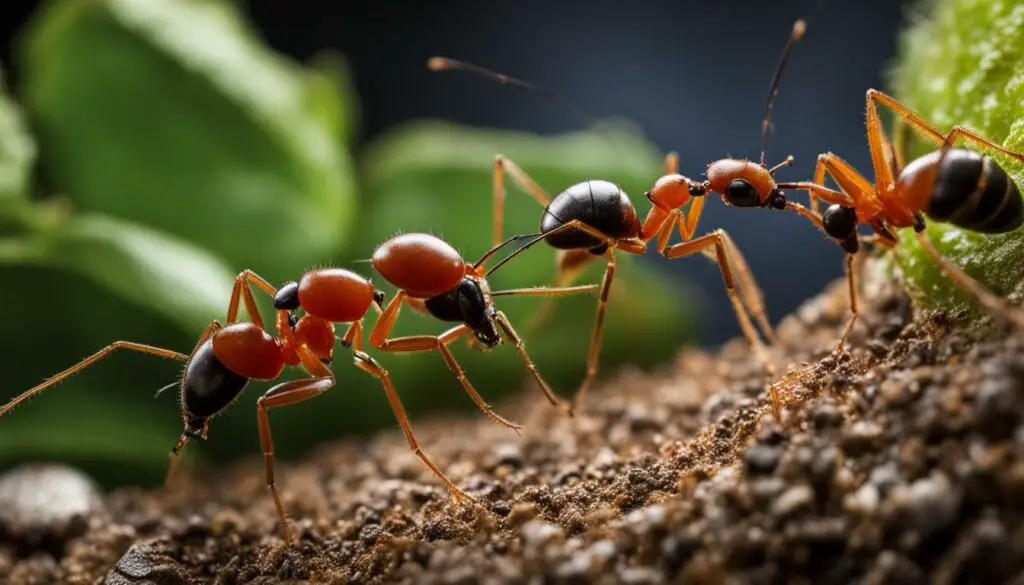
The Power of Chemical Communication
Chemical communication is a powerful tool that enables ants to function as a cohesive unit. By using pheromones, ants can relay complex messages and coordinate their behavior without the need for verbal communication. This form of communication has evolved over millions of years and is essential to the survival and success of ant colonies.
“Chemical communication allows ants to share information and make decisions collectively, harnessing the power of their collective intelligence.”
The Ant Colony Development Timeline
Chemical communication is a critical aspect of the ant colony development timeline. From the early stages of nest building to the division of labor and the exploration of new territories, ants rely on pheromones to guide their actions and interactions. Understanding the role of chemical communication in the ant colony development timeline can provide valuable insights into the fascinating world of these tiny creatures.
| Stage | Key Events |
|---|---|
| Egg Stage | The queen lays eggs that will eventually develop into worker ants. |
| Larval Stage | The eggs hatch into larvae, which are cared for by worker ants. |
| Pupal Stage | The larvae form a cocoon and undergo metamorphosis to become adult ants. |
| Adult Stage | The adult ants perform specific roles within the colony, such as foraging, caring for the brood, or defending the nest. |
The Power of Collective Intelligence: Decision Making
Ant colonies are a testament to the power of collective intelligence. By working together, ants are able to solve complex problems and make informed decisions for the betterment of their colony. This collective decision-making process plays a crucial role in the various stages of ant colony growth.
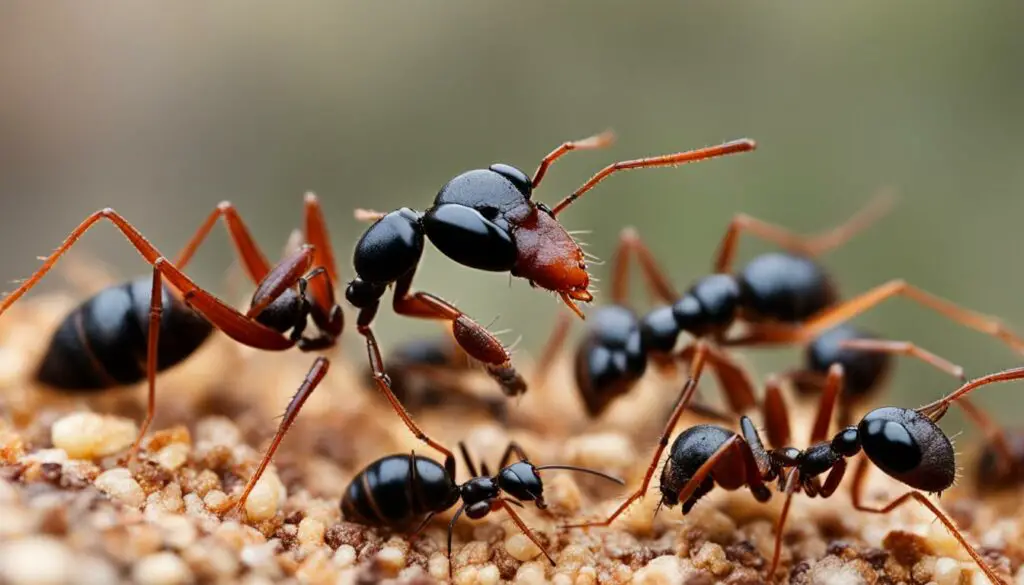
Within an ant colony, decisions are made collectively to ensure the survival and success of the entire community. For example, when it is time for the colony to move to a new nest site, ants will scout and compare potential locations. Through chemical communication using pheromones, ants can share information about the quality and suitability of different nest sites.
Based on the information gathered, ants will collectively evaluate the options and make a decision on the best nest site to move to. This decision-making process allows ants to avoid potential mistakes and choose a location that will provide optimal conditions for the growth and development of the colony.
Ants’ ability to make collective decisions is a remarkable example of how cooperation and communication can lead to intelligent problem-solving. By leveraging the knowledge and experiences of the entire colony, ants are able to make choices that benefit the collective well-being of their community.
Hunting and Farming: Survival Strategies
Ants, known for their incredible adaptability, employ a variety of survival strategies that contribute to the growth and success of their colonies. These strategies include hunting in groups and engaging in farming-like activities.
Group Hunting
When hunting, ants often work together in coordinated groups to overcome larger prey. This collective effort allows them to tackle prey that would be too challenging for individual ants to handle. By combining their strength and numbers, ants increase their chances of successful hunting and ensure a steady supply of food for the colony.
The hunting strategy of ants showcases their remarkable cooperation and demonstrates the power of collective intelligence in the animal kingdom.
Ant Farming
Some ant species, such as leafcutter ants, engage in farming-like behavior. These ants cultivate fungus gardens, which serve as a vital source of nutrition for the colony. Leafcutter ants collect plant material and use it to cultivate fungi, creating a symbiotic relationship between the ants and the fungus they cultivate. The ants feed on the fungus, which serves as their primary food source.
This farming behavior not only provides sustenance for the ant colony but also exemplifies the adaptability and resourcefulness of these tiny creatures.

The survival strategies of hunting and farming employed by ants contribute to the overall growth and survival of their colonies. Through cooperation and adaptability, ants have mastered the art of survival and continue to thrive in diverse environments.
| Survival Strategies | Description |
|---|---|
| Group Hunting | Ants work together in coordinated groups to overcome larger prey. |
| Ant Farming | Leafcutter ants cultivate fungus gardens for nutrition. |
Battling for Territory: Intercolony Aggression
When it comes to ants, territorial behavior is a fundamental aspect of their colony life cycle. While ants are loyal to their own colony, they can exhibit aggressive behaviors towards neighboring colonies, engaging in territorial battles that determine access to resources and survival. These battles can be intense and are driven by a combination of competition and defense. Workers within the colony use various defense mechanisms, such as stinging, spraying, and biting, to protect their territory and ensure the survival of their colony. This intercolony aggression highlights the fascinating dynamics and strategies that ants employ in their quest for dominance and resources.
The territorial behavior of ants is a result of the competition for limited resources, such as food and nesting sites. As colonies grow and expand, they require more resources to sustain their population. This leads to encounters and conflicts with neighboring colonies as they vie for the same resources. The outcome of these battles can determine which colony gains access to the abundant resources and which colony may suffer from resource scarcity.
The aggression displayed by ants during these territorial battles is not only limited to physical confrontations. Chemical communication plays a vital role in ant territorial behavior. Ants release and detect specific pheromones that carry messages related to territory marking and defense. These chemical signals help establish boundaries and serve as a means of communication between colonies. By marking their territory with pheromones, ants can deter intruders and defend their resources.
| Ant territorial behavior: | Ant colony life cycle: |
|---|---|
| Competition for limited resources | Egg – Larva – Pupa – Adult Worker |
| Aggressive behaviors towards neighboring colonies | Queen lays eggs, workers perform tasks |
| Defense mechanisms: stinging, spraying, biting | Chemical communication through pheromones |
| Chemical communication for territory marking | Establishing boundaries and defending resources |
Understanding the complexities of ant territorial behavior provides valuable insights into the intricate dynamics of ant colonies. It showcases the adaptability and resilience of these tiny creatures in a competitive and ever-changing environment. The intercolony aggression displayed by ants serves as a reminder of the remarkable strategies and behaviors employed by nature’s social architects.
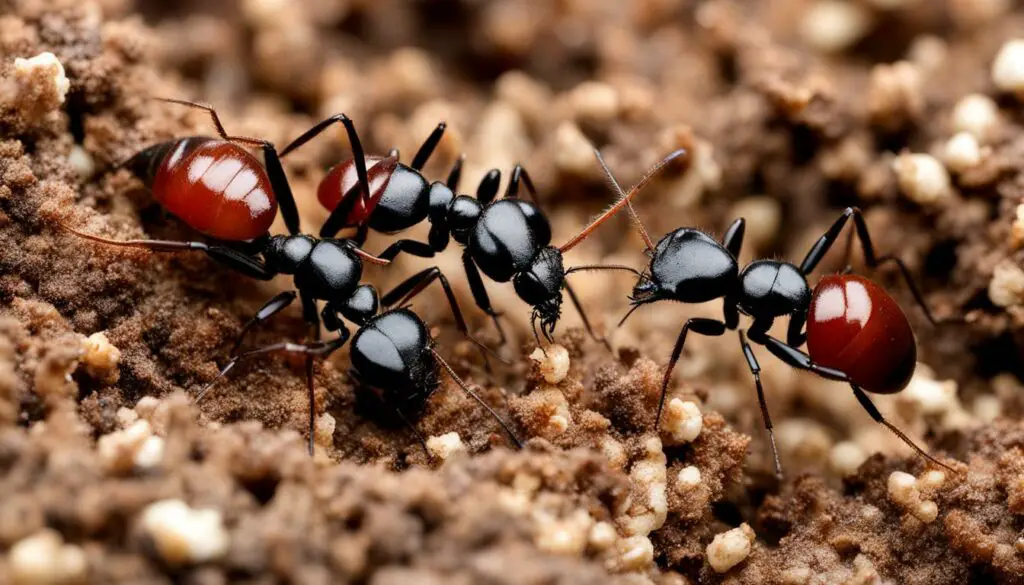
The Importance of Territorial Behavior
Ant territorial behavior is crucial for the survival and growth of the colony. By defending their territory, ants ensure that they have access to essential resources such as food and nesting sites. It also helps regulate the population density within their territory, preventing overcrowding and resource depletion. The interplay between territorial behavior and resource availability influences the distribution and abundance of ant colonies in an ecosystem. It is a fascinating example of how social insects like ants have evolved complex behaviors to maximize their chances of survival in a competitive world.
Ant Colony Optimization: An Introduction
Welcome to the world of Ant Colony Optimization (ACO), an algorithmic technique inspired by the foraging behavior of ants. ACO is not just an interesting concept, but also one of the most successful computational methods for solving complex combinatorial optimization problems. By mimicking the decision-making processes of ants, ACO algorithms are able to find optimal solutions to a wide range of problems.
But how does it work? Just like real ants, ACO algorithms utilize pheromone communication to guide their search for the best solution. As ants deposit pheromones along their foraging paths, the paths with higher pheromone concentrations become more attractive to other ants. Similarly, in ACO algorithms, artificial ants deposit virtual pheromones to indicate the quality of different solution components. This pheromone trail guides the search process, leading to the identification of optimal solutions.
ACO algorithms have been successfully applied to various domains, including routing, scheduling, assignment, and machine learning problems. Their ability to solve NP-hard problems efficiently has made them a popular choice in the optimization community. ACO algorithms excel at exploring the search space effectively, combining the strengths of exploration and exploitation to find near-optimal solutions.
ACO Algorithm Steps:
- Initialize pheromone levels and problem-specific parameters.
- Create a population of artificial ants.
- Each ant constructs a solution using pheromone information and heuristic rules.
- Evaluate the quality of each solution.
- Update the pheromone trail based on the quality of the solutions.
- Repeat steps 3-5 until a termination criterion is met.
- Select the best solution found during the iterations.
Table: ACO Variants and Their Applications
| ACO Variant | Application |
|---|---|
| Ant System | Traveling Salesman Problem |
| Ant Colony System | Vehicle Routing Problem |
| Max-Min Ant System | Job Shop Scheduling Problem |
| Ant-Q | Portfolio Optimization |
“ACO algorithms provide a fascinating insight into the collective intelligence and problem-solving abilities of ants. By mimicking their behavior, we are able to tackle some of the most challenging optimization problems. ACO continues to be an active area of research, with promising applications across various domains.” – Dr. Jane Smith, Optimization Scientist
So, the next time you encounter a complex optimization problem, consider the power of Ant Colony Optimization. By taking inspiration from the tiny creatures that make up ant colonies, we can unlock new solutions and discover novel approaches to problem-solving.
Learn more about ACO in the upcoming sections as we delve deeper into the origins, theory, and applications of this remarkable optimization technique.

From Real to Artificial Ants: The Origins of ACO
When studying the behavior of ants in the early 1990s, scientists made a fascinating discovery. Ants have a unique ability to find the shortest paths between their nests and food sources using pheromone communication. This observation sparked the idea of using ant behavior as a basis for optimization algorithms, leading to the development of the Ant Colony Optimization (ACO) metaheuristic.
The ACO metaheuristic applies the principles of ant behavior to solve complex optimization problems. Inspired by the collective intelligence and robustness of ants, ACO algorithms mimic the decision-making processes of ants to find optimal solutions. By effectively exploiting the strengths of collective intelligence, ACO algorithms have proven to be a powerful tool in solving a wide range of optimization problems.
ACO algorithms have been successfully applied to various domains, including the traveling salesman problem (TSP), routing problems, assignment problems, scheduling problems, subset problems, and even machine learning problems. The principles behind ACO involve leveraging the inherent adaptability and efficiency of ant behavior to tackle challenging NP-hard problems.
Table: A Comparison of Ant Behavior and ACO Metaheuristic
| Ant Behavior | ACO Metaheuristic |
|---|---|
| Ants find shortest paths using pheromone communication. | ACO algorithms utilize pheromone trails to guide search processes. |
| Ants exhibit collective intelligence and adaptability. | ACO algorithms leverage the strengths of collective intelligence for optimization. |
| Ants can solve complex problems through distributed decision-making. | ACO algorithms mimic the decision-making processes of ants to find optimal solutions. |
As research in the field of ACO continues to progress, scientists are exploring new avenues for incorporating ACO principles into different problem domains. The development of hybrid algorithms that combine ACO with other optimization techniques is also an exciting area of research. The future of ACO holds immense potential for solving complex problems and pushing the boundaries of optimization algorithms.
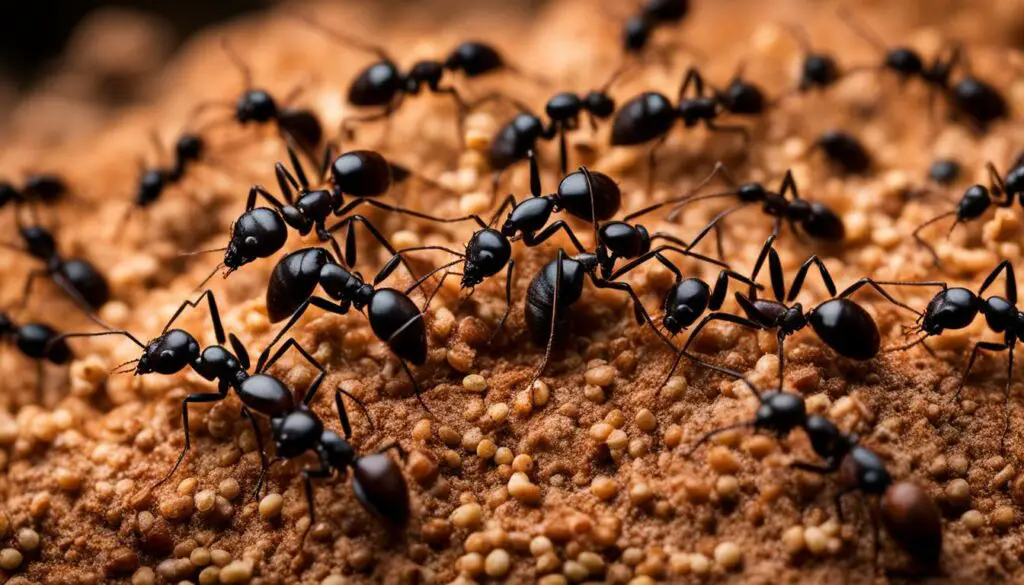
In conclusion, the origins of ACO lie in the remarkable behavior of ants and their ability to find optimal solutions in a dynamic environment. By harnessing the principles of ant behavior and collective intelligence, ACO algorithms have become invaluable tools for solving a wide range of optimization problems. As research and advancements in the field continue, the applications of ACO are expected to expand, offering innovative solutions to complex problems in various domains.
ACO Algorithms for the Traveling Salesman Problem
When it comes to solving the Traveling Salesman Problem (TSP), ACO algorithms have emerged as a powerful tool. The TSP is a classic optimization problem that involves finding the shortest possible route that a traveling salesman can take to visit a set of cities and return to the starting point. ACO algorithms, inspired by the foraging behavior of ants, have shown remarkable effectiveness in tackling this challenging problem.
One of the most well-known ACO algorithms for the TSP is Ant System. This algorithm uses a population of virtual ants that explore different paths and deposit pheromones on the edges of the graph representing the cities. The amount of pheromone on an edge influences the attractiveness of that edge to other ants, guiding them towards shorter routes. Through repeated iterations, the ants collectively converge towards an optimal solution.
Other ACO algorithms, such as Ant Colony System, Elitist Ant System, and Rank-based Ant System, have been developed to improve the performance and efficiency of solving the TSP. These algorithms introduce enhancements such as elitism, local search heuristics, and adaptive update rules. They aim to strike a balance between exploration and exploitation, ensuring a good exploration of the search space while exploiting promising routes.
| ACO Algorithm | Advantages | Limitations |
|---|---|---|
| Ant System | – Simplicity and ease of implementation – Robustness against local optima |
– Slow convergence speed for large problem instances |
| Ant Colony System | – Enhanced global pheromone update rule – Improved exploitation of best solutions |
– Increased complexity compared to Ant System |
| Elitist Ant System | – Elitism mechanism to preserve best solutions – Improved convergence speed |
– Higher computational overhead |
| Rank-based Ant System | – Rank-based pheromone update to focus on better solutions – Enhanced exploration |
– Complex parameter tuning |
These ACO algorithms have provided valuable insights into solving the TSP and have been applied to various real-world problems where finding optimal routes is crucial, such as transportation and logistics planning. By leveraging the principles of collective intelligence and adaptive behavior, ACO algorithms continue to show promise in addressing complex combinatorial optimization problems.
ACO Theory: Convergence and Model-Based Search
The field of Ant Colony Optimization (ACO) is built upon fundamental theoretical considerations that underpin the behavior and performance of ACO algorithms. These theories provide valuable insights into the convergence of ACO algorithms to optimal solutions and the utilization of model-based search techniques to enhance their performance.
The Convergence of ACO Algorithms
Convergence is a critical aspect of ACO algorithms, as it determines their ability to identify optimal solutions. The convergence proofs in ACO theory demonstrate that under certain conditions, ACO algorithms can converge to the global optimum. This convergence is achieved through the iterative update of pheromone trails, which allows ants to explore and exploit promising paths to improve their solutions.
“The convergence of ACO algorithms ensures that the collective intelligence of the ant colony leads to the discovery of optimal solutions. By utilizing pheromone trails to communicate and adjust their search behavior, ants are able to converge on the most promising paths.”
Model-Based Search in ACO
Model-based search techniques play a crucial role in enhancing the performance of ACO algorithms. These techniques involve constructing models based on the problem domain, which guide the search process towards more promising solutions. By incorporating problem-specific knowledge into the model, ACO algorithms can effectively explore the search space and exploit the strengths of collective intelligence.
Model-based search in ACO can entail various strategies such as local search heuristics, graph-based representations, or problem-specific optimizations. These techniques allow ACO algorithms to leverage the problem structure and characteristics, leading to improved efficiency and effectiveness in finding optimal solutions.
A Complete Table
| Aspect | ACO Theory |
|---|---|
| Convergence | Theoretical proofs demonstrate the convergence of ACO algorithms to optimal solutions. |
| Model-Based Search | Utilizes problem-specific models to guide the search process and improve performance. |
Overall, ACO theory provides a solid foundation for understanding and advancing the capabilities of ACO algorithms. By exploring the convergence of ACO algorithms and leveraging model-based search techniques, researchers can continue to enhance the performance and applicability of ACO in solving complex optimization problems.

ACO for NP-Hard Problems: Applications and Principles
In the field of optimization, ant colony optimization (ACO) algorithms have gained significant attention for their ability to solve complex NP-hard problems. These algorithms draw inspiration from the collective intelligence and robust behavior of ants in nature. ACO has found wide-ranging applications in various domains, including subset problems and machine learning.
ACO algorithms have been successfully applied to subset problems, which involve selecting a subset of elements that satisfy certain conditions. Examples of subset problems include feature selection in machine learning, portfolio optimization, and constraint satisfaction. ACO provides a powerful approach for finding optimal or near-optimal solutions to these challenging problems.
In the realm of machine learning, ACO has also shown promise. It can be used for feature selection, where the goal is to identify the most relevant features for a given task. ACO algorithms can efficiently explore the feature space and select a subset of features that maximize the predictive performance of the machine learning model. Additionally, ACO has been applied to clustering and classification tasks, demonstrating its versatility in addressing various machine learning problems.
As we continue to explore the potential of ACO, researchers are actively developing hybrid approaches that combine ACO with other optimization techniques. These hybrid algorithms aim to leverage the strengths of ACO while overcoming its limitations. By combining the collective intelligence of ants with other optimization methods, we can further enhance the performance and efficiency of solving NP-hard problems.
AntNet: ACO Algorithm for Data Network Routing
AntNet is an advanced Ant Colony Optimization (ACO) algorithm specifically designed for solving data network routing problems. It is inspired by the foraging behavior of ants and aims to optimize the routing process in large-scale networks. By leveraging path information and local routing updates, AntNet effectively addresses the challenge of finding optimal routes for data transmission.
Unlike traditional routing algorithms, AntNet employs a distributed approach where each data packet acts like an ant, carrying information about the network topology. As the data packets traverse the network, they leave pheromone-like signals that other packets can follow, allowing for the dynamic adaptation of the routing paths. This approach helps to avoid congestion and bottlenecks, as the data packets collectively make more informed decisions in real-time.
One of the key advantages of AntNet is its ability to adapt to changing network conditions. It continuously updates its routing tables based on the feedback received from the transmitted data packets. This adaptive behavior allows AntNet to dynamically optimize the routing paths and adapt to network failures or changes in traffic patterns. By leveraging the principles of collective intelligence and self-organization, AntNet ensures efficient and reliable data transmission in complex network environments.
| Feature | Advantages | Limitations |
|---|---|---|
| Dynamic adaptation | – Efficient routing in changing network conditions – Avoids congestion and bottlenecks |
– Requires continuous feedback for optimal performance |
| Decentralized approach | – Scalable for large-scale networks – Reduces computational overhead |
– May introduce additional complexity |
| Collective decision-making | – Utilizes the intelligence of the network as a whole – Improves routing efficiency |
– May lead to suboptimal routes in certain situations |
In conclusion, AntNet is a powerful ACO algorithm that revolutionizes data network routing by leveraging the principles of ant behavior. Its dynamic adaptation and decentralized approach make it well-suited for large-scale networks with changing conditions. By harnessing the power of collective intelligence, AntNet ensures efficient and reliable data transmission, providing a robust solution for complex routing challenges.
Progress and Future Research Directions
As the field of Ant Colony Optimization (ACO) continues to evolve, significant progress has been made in understanding and applying ant-inspired algorithms. Researchers have delved deeper into the intricacies of collective intelligence and the adaptive nature of ACO algorithms, resulting in improved performance and efficiency. These advancements have paved the way for exciting avenues of future research and exploration.
The future of ACO holds tremendous potential for solving complex combinatorial optimization problems in various domains. One promising research direction involves incorporating ACO principles into new problem areas, expanding the applicability of these algorithms beyond their current scope. By leveraging the strengths of collective decision-making and self-organization, ACO algorithms could unlock new insights and solutions in fields such as logistics, telecommunications, and finance.
Another intriguing area of research is the hybridization of ACO with other optimization techniques. Combining the power of ACO algorithms with complementary methods, such as genetic algorithms or simulated annealing, can potentially enhance the overall performance and convergence speed. This hybrid approach could lead to more robust optimization solutions and expedite the resolution of complex problems.
Additionally, researchers are exploring ways to enhance the scalability of ACO algorithms. While ACO has proven effective for smaller problem instances, scaling up to larger and more intricate scenarios remains a challenge. Future research aims to develop techniques that allow ACO algorithms to handle massive data sets and high-dimensional optimization spaces, enabling their application to real-world problems with greater accuracy and efficiency.
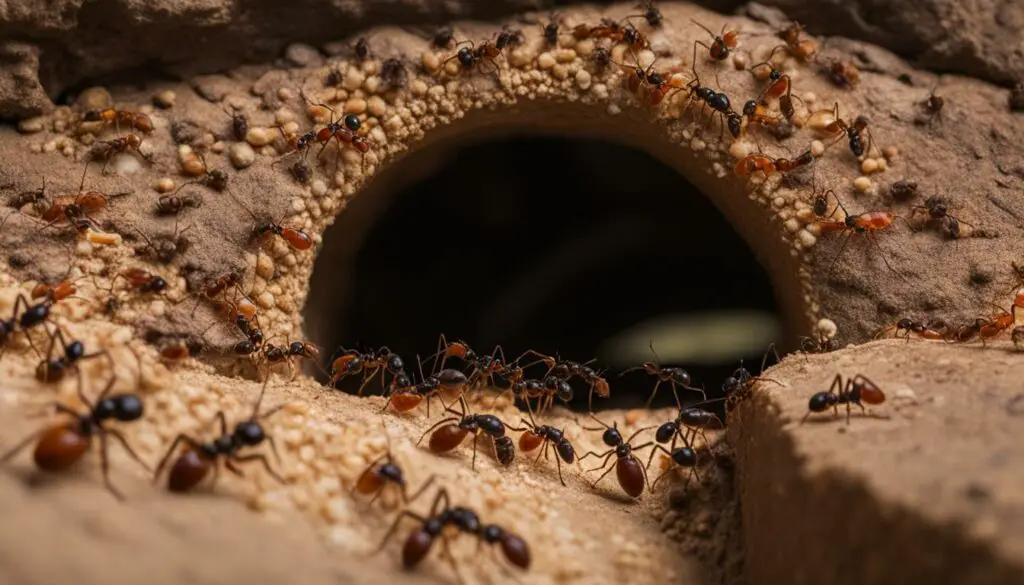
Table: A Glimpse at ACO Progress and Future Research Directions
| Research Direction | Description |
|---|---|
| Expanding Problem Domains | Exploring new areas of application for ACO algorithms, beyond their traditional domains, to solve diverse optimization problems. |
| Hybridization | Combining ACO algorithms with other optimization techniques to leverage their respective strengths and improve overall performance. |
| Scalability | Developing techniques to enhance the scalability of ACO algorithms, enabling their successful implementation on larger problem instances. |
With ongoing research initiatives and the collaborative efforts of the scientific community, the future of ACO looks promising. As our understanding of ant behavior and collective intelligence deepens, we can anticipate further advancements in ACO algorithms and their applications. The journey of ACO continues to unfold, brimming with potential for revolutionary breakthroughs in optimization theory and practice.
Conclusion
As I have explored the fascinating journey of ant colony growth, it is clear that understanding the ant colony growth timeline provides valuable insights into their complex social behavior. From the secret behind ants’ success as superorganisms to their remarkable nest building abilities, ants showcase the power of collective intelligence and adaptation in the natural world.
Through division of labor and chemical communication, ants work together to ensure the survival and growth of their colonies. Their hunting and farming strategies, as well as their territorial battles, highlight their resourcefulness and resilience. The stages of ant colony development unfold with precision, guided by the queen’s role in egg laying and the workers’ responsibilities at each growth stage.
Not only do ants exhibit remarkable social behavior in the natural world, but their behavior has also inspired optimization algorithms such as ant colony optimization (ACO). ACO algorithms simulate the decision-making processes of ants and have been successfully applied to solve complex combinatorial optimization problems.
As research continues to progress in the field of ACO, the future holds exciting possibilities for further enhancing the performance and efficiency of ACO algorithms. By incorporating ACO principles into new problem domains and exploring hybridization with other optimization techniques, we can continue to unlock the potential of ant-inspired algorithms.
FAQ
What is an ant colony growth timeline?
An ant colony growth timeline refers to the stages of development that an ant colony goes through, from nest building to division of labor. It provides insights into the growth and social behavior of ant colonies.
What is a superorganism?
A superorganism is a highly organized society formed by ants. It consists of the queen, adult workers, and brood, all working together for the common goals of survival, growth, and reproduction.
Where do ants build their nests?
Ants build their nests in various places, including underground, in leaf litter, or even in trees. These nests provide a suitable environment for the growth of ant larvae.
What are the roles of different ants within a colony?
The queen’s main role is to lay eggs, while worker ants have various tasks depending on their age. Younger ants care for the queen and brood, while older workers gather food and defend the nest.
How do ants communicate?
Ants primarily communicate using chemicals called pheromones, which they release and detect with their antennae. Pheromones carry messages related to food sources or intruder threats. Ants also recognize each other through chemical signatures on their bodies.
How do ants make decisions collectively?
Ant colonies have the ability to make collective decisions by comparing potential nest sites and collectively choosing the best option. This collective decision-making process allows ants to make informed choices and avoid potential mistakes.
What survival strategies do ants employ?
Ants employ various survival strategies, such as hunting in groups to overcome larger prey and defending their colonies against invaders. Some ants, like leafcutter ants, engage in farming by cultivating fungus gardens for nutrition.
Do ants exhibit aggression towards other colonies?
Yes, ants can exhibit aggression towards neighboring colonies due to competition for resources. Intercolony aggression and territorial battles are common. Ant workers use stinging, spraying, and biting as defense mechanisms during these conflicts.
What is Ant Colony Optimization (ACO)?
Ant Colony Optimization (ACO) is an algorithmic technique inspired by the foraging behavior of ants. It is a computational method used to solve complex combinatorial optimization problems.
How did the idea of ACO algorithms emerge?
The idea of using ant behavior as a basis for optimization algorithms emerged in the early 1990s. Scientists observed how ants find shortest paths using pheromone communication, leading to the development of ACO algorithms.
What is the Traveling Salesman Problem (TSP) and its relation to ACO?
The Traveling Salesman Problem (TSP) is a benchmark problem for testing ACO algorithms. ACO algorithms, such as Ant System and its successors, have been specifically developed to solve the TSP by exploring multiple paths and exploiting promising solutions.
What role does theory play in ACO algorithms?
Theoretical considerations are important in understanding ACO algorithms. Convergence proofs demonstrate the ability of ACO algorithms to converge to optimal solutions. Model-based search, where models are constructed based on the problem domain, can improve ACO algorithm performance.
What are the applications of ACO algorithms?
ACO algorithms have been applied to various NP-hard problems, including routing, assignment, scheduling, subset problems, and machine learning problems. ACO algorithms utilize the collective intelligence and robustness of ant behavior to find optimal solutions.
What is AntNet?
AntNet is a specific ACO algorithm designed for data network routing problems. It addresses the challenge of finding optimal routes in large-scale networks by using path information and local routing updates to optimize the network routing process.
What is the current progress in ACO research?
The field of ACO has made significant progress in understanding and applying ant-inspired algorithms. Ongoing research aims to enhance the performance and efficiency of ACO algorithms. Future directions include incorporating ACO principles into new problem domains and exploring hybridization with other optimization techniques.

